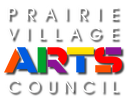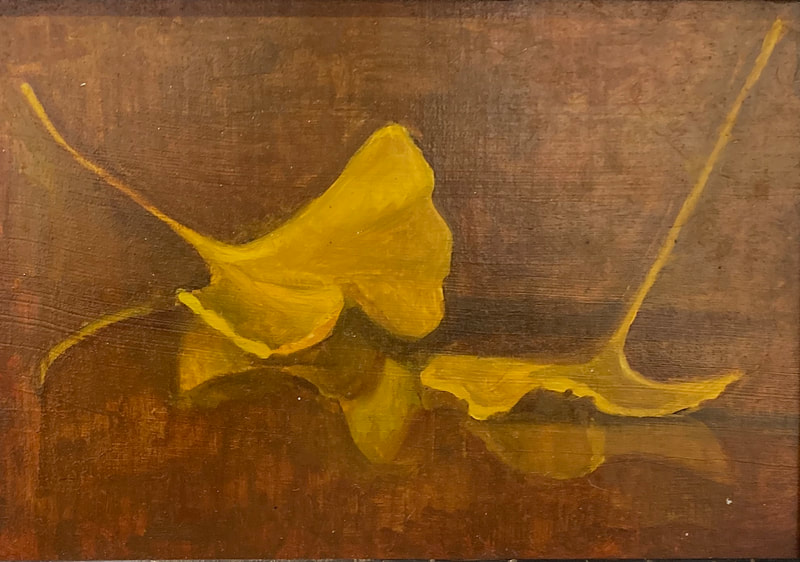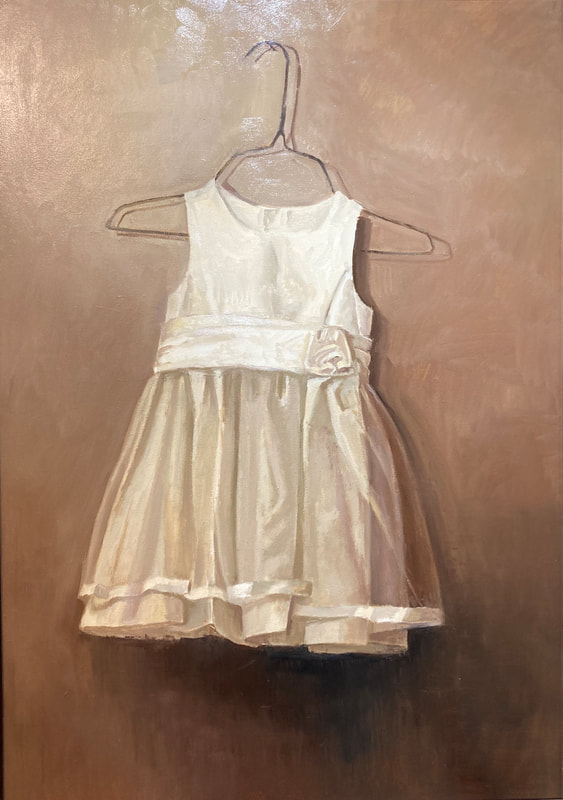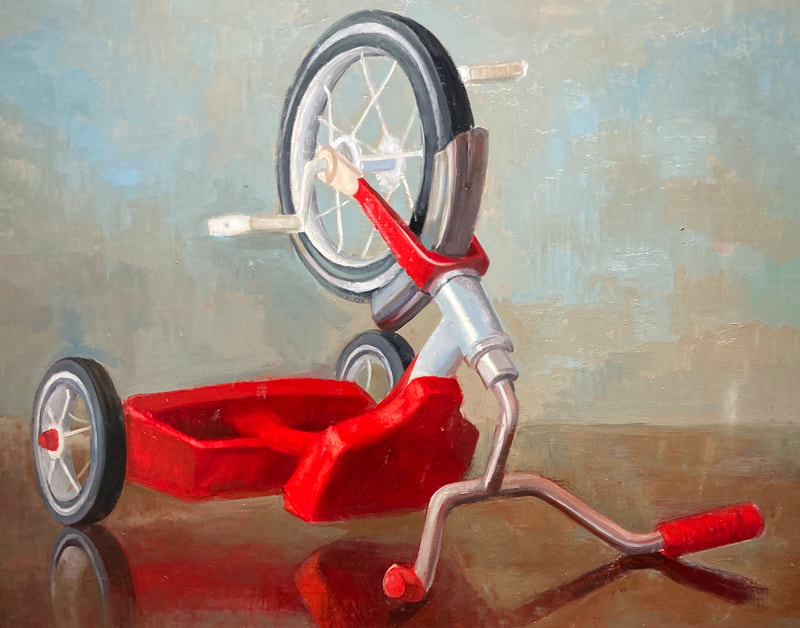|
By Bob Bahr, PV Arts Council member
Yes, the sunflowers are beautiful here in the fall, but one of the most consistently beautiful things in this part of the country, year-round, is the sky. The wispy clouds of summer don't always shield us from the sun, but they rake the sky with cottony streaks. The incredible peaches and cyans of sunsets of winter end our workdays with a soft lightshow. The flat fields serve up a warm platter for the brilliant skies above. But it's easy to stop seeing the everyday beauty. Donna J. Paul is here to help. "I want the viewer to say, 'Wow, there really is something to see in the landscape of Kansas, and the Midwest, and Lawrence in particular," says the artist, who grew up in Ohio but has lived in the Kansas City area since the mid-1970s. "It's not an in-your-face beauty, but the more you look and the closer you see, the more you find there." Paul works in both pastels and oil paints, and she pursues a kind of accessible abstraction in her work that suggests as much as it describes. Although she says she may prefer pastels over oils, her oil paintings have a marvelous way of somehow holding onto the vibrant color associated with pastels and the direct feel of pastel sticks--each mark on her oil paintings seems visible. The viewer can see her hand in the work. "Pastels are my first love," says Paul. "I have drawers and drawers filled with pastels at home. In the summer, I can work with the windows open, which is important with pastels. It's a health issue. [The dust from pastel pigments is toxic for both lungs and skin.] I work with oils in the winter. The subject matter doesn't really matter in terms of medium." Quite a few of Paul's pieces that are currently on view at the R. G. Endres Gallery, in the Prairie Village Municipal Offices, are landscapes. Paul reports that many were inspired by her morning walks with her husband around the outskirts of Lawrence. If a viewer can see individual pastel strokes with a careful look at her pastel paintings, the look of her oil paintings done without a brush is even more striking. Paul almost exclusively paints in oils using some sort of palette knife or scraper. "It started when I wanted to be bolder and looser in my art, and there's no other way to be with a palette knife," she says. "This technique suits the Kansas landscape--flat land, lots of sky, big shapes." Paul employs the typical kind of palette knife, with a triangle or blade shape and a wooden handle, but she also uses a bowl scraper and a soft, plastic, wedge-shaped tool from Catalyst. If she uses a brush at all, it's a big, inexpensive one from the hardware store. Her color palette is not extensive; Paul places a warm and a cool version of the primary colors (red, yellow, blue) on her palette before painting. She also adds an unusual color such as persimmon or Montserrat orange to shake things up. "I'm a sucker for new paint colors, and I'll try one surprise color per painting," she says. "I'll add something bright and in-your-face and sneak that in." Her current influences are pastelists, including Albert Handell and two pastelists from Scotland: Tony Allain and Norma Stephenson. "What I get from them is 'big shapes, bold colors, and extrapolating from the landscape rather than copying it,'" she says. Paul has taken workshops with the New Mexico-based Handell, and she took a drawing class art an arts center in Lawrence, but she's mainly self-taught. "I retired from being a pharmacist about 12 years ago, and I knew I needed something to keep me busy," says Paul. What's next for Paul? She has plans to do a series of night sky paintings in pastel. For these, she will work on pastel paper that is already toned either in a dark salmon or black. Don't count on these paintings showing famous landmarks. "What attracts me to a scene first, like most people, is the contrast between light and dark," says Paul. "But at the same time, I like to pick subject matter that is kind of out of the way. You may just walk past it and not think too much about it. These everyday landscapes--I want to make the mundane special." Bob Bahr is a member of the Prairie Village Arts Council. He has written about visual art for several national magazines. He lives with his family in Prairie Village and paints a variety of subjects. He wishes there was a NYC-style bodega in the Shops.
0 Comments
by Bob Bahr, PV Arts Council member
Debra Payne has seen a lot of art in her time. She taught art at Liberty High School for 30 years, teaching students how to draw and paint. So, before even counting the art she has looked at for her own enjoyment, Payne has examined thousands of thousands of paintings and drawings. She knows what it takes to execute art effectively, and she knows how art can go further to make a dramatic impression on the viewer. This explains why, when a viewer pauses in front of her painting "Flower Girl's Dress," currently on view at the R. G. Endes Gallery, in the Prairie Village Municipal Offices, the painting exerts itself beyond a superficial reading of any old dress. Exquisitely painted, it begs for a narrative. I'm afraid the viewer will have to provide that story. Payne may imbue her paintings with emotion, but there is no grand narrative at play. "A lot of my subject matter is just stuff that I think will look cool in a painting," Payne says. "Objects that are discarded--it's just things that I'm personally drawn to, maybe all the stuff in my recycling box." The key is the alchemy that artists bring to something, the transformation of an everyday object into something interesting to behold. 'I hope the viewer recognizes what I'm depicting but see it like for the first time," says Payne. "I hope that they can identify the subject but are wowed by the painting of it. I'm always pursuing the 'cool' factor." That elevation of the mundane is something she taught her students. A beautiful dress for a young girl is already a work of art…but an old, used-up flip-flop? Payne has long understood shoes to be a good subject for a painting. If one needs precedents in art history, they are there. Google Van Gogh's painting of shoes, for example. Andrew Wyeth's tempera painting of his boots treading on a weed. But most of all, Payne found shoes useful for teaching her art students. "When I was teaching high school kids, I was always looking for things to draw--things readily available and not too precious," says the artist. "Never use candy in a still life--they are always so hungry, so they will eat it--even if it is glued down! Shoes work well because we all have such a strong symbol in our brains for what a shoe looks like. Same with a flip-flop. To correctly draw a shoe--and to me, painting is just an offshoot of drawing--you have to give up on the idea of drawing the symbol. What do you really see? What shape do you actually see? I still like painting shoes today. This summer I'm going to paint shoes a lot bigger. I don't know if it will be a series, but I will return to shoes. I'm also going to paint some pieces with those magnetic letters that people put on refrigerators. I am raising chickens so I am going to paint them as well." Payne sometimes paints outdoors, and she likes it, but the weather and the sunlight changes rather quickly, making it a challenge to capture the scene. So she prefers to carefully arrange objects and set up lights in her studio to prepare her subject matter. "I spend a great deal of time setting it all up, but I find that if I have a really solid plan, it's unlikely that the painting process will falter. I like to feel pretty confident in what I'm doing for it to be a success." Before the pandemic she enjoyed participating in several artist residencies. Payne would paint in a community for one week in all four seasons, depicting the local beauty. That's preferable to some outdoor painting events, where painters compete to paint the "best" painting over a week or weekend. "Residencies were more doable," Payne says. "It was still hard work, but I had the opportunity to take as much time as I needed, to repeat a painting, or to return to the same scene a couple of times to finish a piece to my satisfaction." Payne reports that these paintings of local communities, including Lindsborg, Newton, and Marysville, appeal to collectors who appreciate a small-town vibe. Payne clearly appreciates the Prairie Village vibe. She grew up in Johnson County and graduated from Shawnee Mission West. She "married a boy from Shawnee Mission South," and earned a master's degree in art education from KU (much of it off-campus) after graduating from Emporia College. Now retired, she paints what she wants, the way she wants. "It keeps me off the streets," she says with a laugh. Bob Bahr is a member of the Prairie Village Arts Council. He has written about visual art for several national magazines. He lives with his family in Prairie Village and paints a variety of subjects. He wishes there was a NYC-style bodega in the Shops. |
AuthorWrite something about yourself. No need to be fancy, just an overview. Archives
May 2024
Categories |











 RSS Feed
RSS Feed